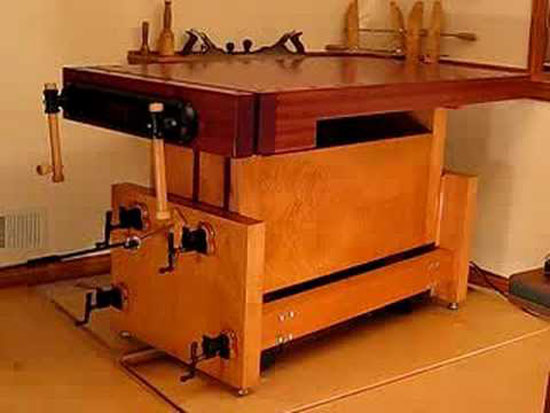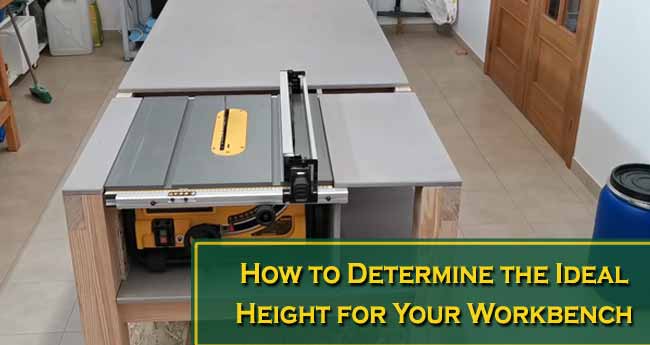A common question that people ask when starting as a craftsman is what’s the ideal height for a workbench? If you’re one of them, then this article is for you. Are you wondering how to determine the ideal height for your workbench? Take it easy.
There’s no fixed answer written in stone for that question of yours. However, we can help you build a bench that’s custom-fit for your body type and the category of work you will use it for. If you already have a workbench, but you’d like to upgrade a few things, then the tips here might be something to consider first.
A too high or too low workbench will cause strain to your body. Long-term use of a bench that doesn’t fit your height is bound to give you headaches and back pain one way or another.
So, here we’ve listed ways to solve the issue.
Importance of Workbench Height
Before we get into the details, you need to be aware of how important your workbench height is. In hindsight, it might seem trivial, but working at the wrong bench can have many damaging effects in the long run.

Usually, any strenuous manual work you might do will put a certain amount of stress on your muscles. It might appear simple, but that’s not quite it.
Low Height
Woodworking and other forms of craftworks usually consist of a healthy mix of pushing, stretching, moving, and pulling the different parts of your body. If anything, it’s supposed to help you stay even more fit and healthier!
Unfortunately, that’s not what happens while standing in front of a workbench. At a table, you have to repeat the same motions of work again and again for hours at a stretch. This sort of repeated motion results in the most common health problem like lower back pain.
So, now you know why that back of yours has been cramping so much. You’re probably using a bench that’s too low for you.
High Height
Now, you might be wondering what’s going to happen if your bench is too tall for you. Well, besides causing a strain to your eyes, long term use of such a table will give you headaches. This is because your upper body will be put through too much stress unnecessarily.
What you’ll need is a large workbench with a surface top wide enough to work on comfortably. It has to be of the optimum height where you don’t need to put so much strain on your upper body to reach its surface. There’s a certain balance of height and width that needs to be maintained.
So, while picking out a new worktable or making one, always make sure its height is a custom-fit for your body type and work type. Not only will this improve your health, but it will also significantly improve the quality of work you put out too. Sounds awesome, right?
Measurements to Consider for Your Bench
Whether you’re building a wood workbench or a table meant for working with different materials, there’s a list of things to consider measuring first.

You have to pay a lot of attention to make sure it’s all accurate. That’s the only way to build a top-notch workbench. Here are three things you’ll need to be careful about while building your bench:
Depth
The depth of your workbench should ideally be 24 inches. You can increase a couple of inches depending on whether or not your work involves larger than usual workpieces. Keep in mind that your arm needs to be able to cross the entire table width.
Length
This is more of a personal preference. Unlike with the height and depth, you can make your bench as long or short as you like. But bear in mind that longer benches usually need wood, which is more stable and sturdier.
Height
And last but not least, consider the height. Do not neglect this factor unless you want back pains or neck strains daily. The safest way to go is to keep your bench somewhere near 36 inches in height. Of course, this measurement is flexible, depending on your height.
If you’re a hand-tool enthusiast, then you might need a bench lower than your normal reach. But a power-tool lover will need a few inches more than that.
Determining the Correct Height
To build a worktable suited for your height, you need to measure your height first. And to do so, you’ll need to stand against a wall being parallel. Your arms should lay straight on either side with the palms faced upward.
This is important. Because you’ll need to measure the distance from the floor to the inside of your wrist’s crease; that will be the height you need.
Height for General Woodwork
Compare this measurement to the height of the bench you’re using or building. You can compare it with the help of a measuring tape or just use some string. Of course, there’s the option of marking the wall too.
You’ll find that adding or reducing a few inches might assist your work type greatly. Also remember that despite seeming short, a workbench’s height can be relative to how you position yourself.
While doing projects at the table, you are bound to change your stance and stay like that for hours. This is even truer for heavy-weight activities that require extra power.
Try to set the work surface of your bench to be even with the bottom of your shirt cuff. It will provide you enough space for most jobs you bring to the table like joinery and construction.
But if you often do sanding, cutting, shaping, etc. types of work, then the height should be a bit lower. If you drop it to around 6 inches below the shirt cuff, it’ll allow you to use the full weight of your shoulders and arms to maneuver the tools.
Height for Assembly and Repair Woodwork
But what if you’re into assembly and repairs? Setting your shirt cuff as the base, move the bench 6 inches higher. That’ll let you see properly what you’re doing, and you don’t have to bend over all the time. You can take a look at some workbench plans to decide on how to build yours.
Workbench Heights for Woodworkers
Most woodworking benches come with heights ranging from 33 inches to 36 inches. If you’re of average height, you might be comfortable with that already. But even a change of an inch or two can make you feel a big difference. It’s good to experiment before settling on just one thing.
No doubt, there’s a lot to consider when you’re building a woodworking table. From looking at the wood moisture meter reviews to shopping for the best wood slabs, it’s bound to get tiring. There’s nobody who would want the added trouble of working forever on a bench that’s just not convenient.
Adjust the height by increasing or decreasing the lengths of the legs on your workbench. Make sure to match it with the height of the floor from the crease of your wrist when you do make alterations and adjustments.
Suppose your height is 5 feet 10 inches or more. Then the height from your crease might be around 35 to 37 inches. This might seem a bit too much compared to the worktables being sold out in the market. But rest assured, it’s not.
The reason why old woodworking tables had a lower height was that the general population was considered shorter than now. Every person is different, and so their work styles also vary. It’s precisely for this reason that building your own bench for work is so heavily encouraged by woodworking experts.
Final Words
For any craftsman, having what’s best suited is a huge factor for success. The best router table, the best workbench, the best tool kit you want it all. So, by determining the ideal height for your workbench, you’ll be a step closer to that goal of success.
Recommended To Read:
- Our Top 6 CNC Router Spindle List For You
- Select Wax For Chalk Paint From Our List

